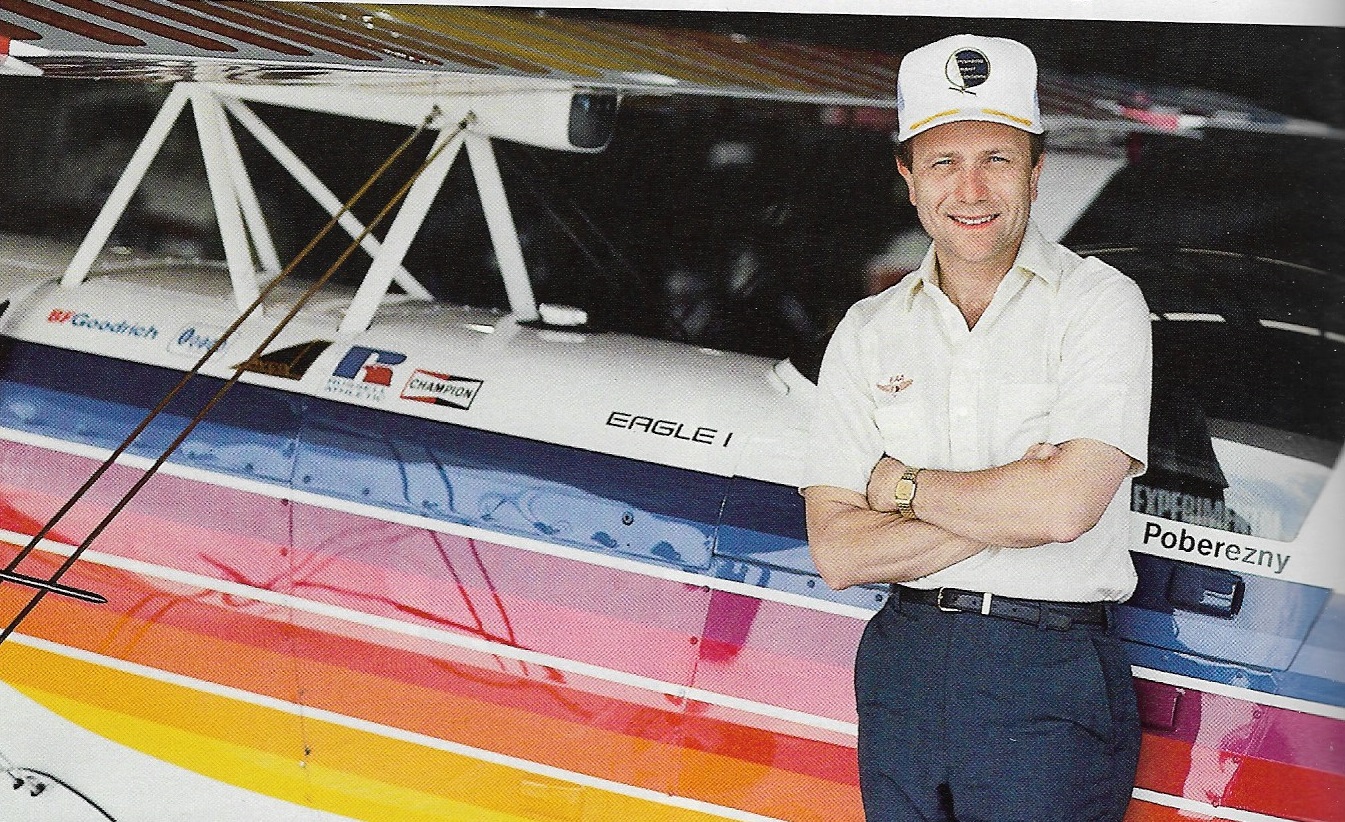
1998 - Tom Poberezny
Sport Aerobatics December 1998
The Utmost Distinction
The greatest honoe in aerobatics is enshrinement into the Aerobatic Hall of Fame.Recently, the International Aerobatic Club welcomed the newest members of the Hall of Fame - Rod Jocelyn, Tom Poberezny, and post humous inductees Bill Barber, Harold Neumann and Tex Rankin. The five were inducted during ceremonies October 23 at the EAA Aviation Center in Oshkosh, Wisconsin.
The Aerobatics Hall of Fame was formed in 1986 to give appropriate acclaim to those persons who have made a significant contribution to aerobatics. The following year in 1987, Jose Aresti, Duane Cole, Curtis Pitts and Frank Price became the first inductees to receive this prestigous honor.
In subsequent years, such greats as Marion Cole, Mike Murphy, Betty Skelton Frankman, Bob Heuer, Bevo Howard, Harold Krier, Lincoln Beachey, Bob Herendeen, Charlie Hillard, Art Scholl, Mary Gaffaney, Leo Loudenslager, Clint McHenry, and Neil Williams gained this distinction as well. A place of honor is set aside in the EAA Air Venture Museum in Oshkosh, Wisconsin to recognize their accomplishments. They are now joined by the 1998 inductees.
Sport Aerobatics April 1999
Setting the Pace for Excellence and Leadership
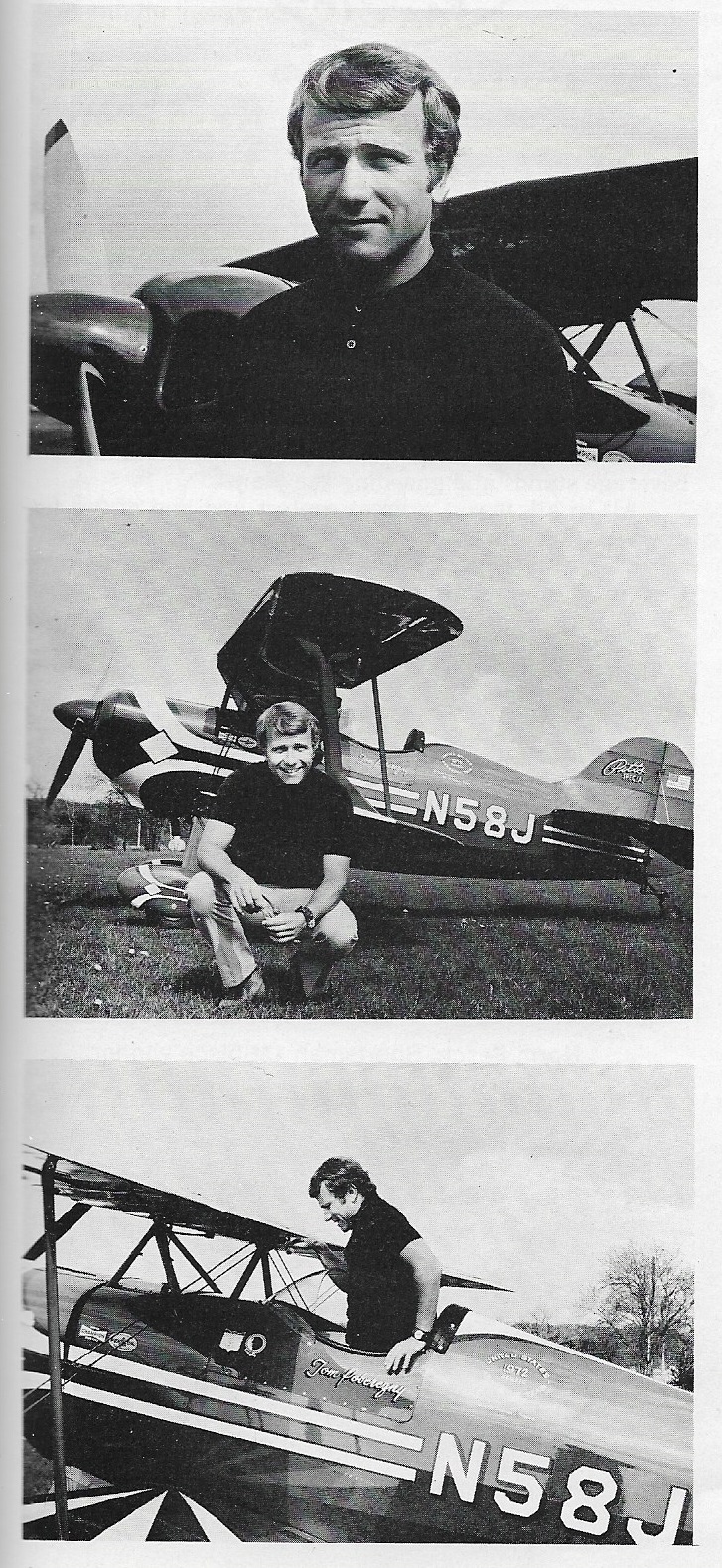

Interview by Dave Lammers, IAC Vice President, and Aerobatics Hall of Fame Chair
Lammers: Tell us what it was like growing up in the Poberezny family where household names were those we now find in the Aerobatics Hall of Fame - names like the Cole Brothers, Harold Krier and Mary Gaffaney,
Poberezny: EAA was started in 1953. I was seven years old. The early meetings were held in the basement of our home. Every Friday night people would come over and talk airplanes with my Dad. They were friends. People like the Cole brothers didn't come as air show people, but as pilots. Competition as we know it today didn't exist. There were air show fly-ins and competitions, but they were more lossely organized and the rules were not as rigid. My interest in aerobatics didn't develop until later. When you have something that is in front of you, you don't worry about it, because you know it's always there. I guess part of it was when I was growing up, I wanted to be sure that if I got involved in aviation it was because I wanted to and not because of my dad's expectations. I'm sure, in private, Dad wanted me to pursue an aviation career, but he didn't push.
Lammers: Tell us about how you got started in aerobatics.
Poberezny: My dad always had a building project in the garage. He had a close relationship with Curtis Pitts. The first Pitts we built was the flat-wing, two aileron version. We wer about 3/4 of the way through when the new Pitts came out with the four-aileron, symmetrical wing. I realized that for fun flying, the one we were building was fine, but if we were ever going to do anything further, I needed the updated version.
In the meantime, I met Gene Soucy and his father Paul. They had two Pitts Specials, the first flat wing and the second Curtis' newest version. Gene and I were very close in age. At that time, for someone Gene's age to rise so fast was remarkable. Most of the competitors and performers were guys like Harold Krier, Art Scholl, Frank Price and Bevo Howard. Here comes this young kid out of Louisville, Kentucky, who was a little cocky. Gene and Paul asked if I wanted to travel with them to Canada and other places, flying the second Pitts. I had all of about 30 minutes in a Pitts at that time.
I went to Louisville, and they checked me out. I remember clearly that first flight thinking, "This is really something." That was in 1970 at Bowman Field. There were parallel runways with flight training going on everywhere. I lined up for the landing. I thought, "This is a piece of cake." Then I landed, it all broke loose. Before I knew it, one "S-turn" go bigger than the other, and I scraped the wing tip. It didn't groudn loop, but it got up on one gear. I remember taxiing in and want to bury myself in a hole. L. Paul Soucy's Pitts's were immaculate and were his pride and joy. He walked up, looked at me and said, "Get back up there!" I'm sure he was torn up inside, but he pushe me back out to the runway and off we went. I never nicked another airplane. That's what got me started - being on the road with Gene. I started by announcing for him. We would spend a couple of days at different shows and between shows he would say, "Okay, go up to 2-3000 feet and try this," and he'd watch me. I learned my aerobatic with Gene briefing me on the ground.
Lammers: What was your first IAC contest experience?
Poberezny: My first competition was at Monroe, Lousianna. I flew Intermediate. It was the same weekend I was graduating from Northwestern University. I won, and at the banquet when I received my trophy, they gave me a graduation certificate - a picture of me in front of the airplane signed by the competitors with a ribbon attached. I still have it at home.
Lammers: How about moving up to Unlimited? Did you go through Advanced first?
Poberezny: Yes, in fact, I flew Advanced at the Natoinals that year. I went through the Intermediate/Advanced cyhcle that first year, and in 1971, I continued on. To be honest, I never thought that a year later I would be trying to make the U.S. Team, competing against people like Charlie Hillard, Art Scholl and Gene Soucy.
Lammers: As you were preparing for that, who were your coaches?
Poberezny: Gene, almost exclusively. That's a period of my life I will never forget. We went to Oak Grove Airport, the headquarters of the Aerobatic Club of America. Pappy Spinks was the president. We would be there at different times, staying at what was called the "Spinks Hilton". It was at the airport and was a barracks type building...very basic. Gene and I shared a room. We were the only ones there except for one other person - Leo Loudenslager. Leo showed up with his new Stevens Akro, and as everybody knows, Leo was pretty intense, focused person. We practiced together. Leo was just getting started and was making the jump, as I remember, from no competitoin to Unlimited. He was the kind of guy who took big steps. Evey morning Charlie Hillard would be out at about 7:00 a.m., banging away in the sky. We started to develop a relationship. Between watching Charlie and flying four-five-six flights a day with Gene, we had intense daily practice. Physically and mentally I was prepared.
The day before the competition started, we were at the Holiday Inn near Oak Grove Airport and ran into Frank Christensen. Frank was going to cmpete in Unlimited also. He said, "What happened to you?" I said, "What do you mean?" He said, "Your eyes are all red." I said, "I broke some blood vessels while practicing." Frank said, "How come that didn't happen to me?" And I said, "Well, Frank, you're not pushing hard enough." To this day, Frank keeps bringing that up. It was intens, focused training. I was fortunate my parents gave me the opportunity. I was only 21 or 22. The pilots I met made me think about the level of competition - realizing the people I would be flying against had year and years of experience.
Lammers: You were on the team that won the World Championships at Salon, France in 1972. How did you prepare for that?
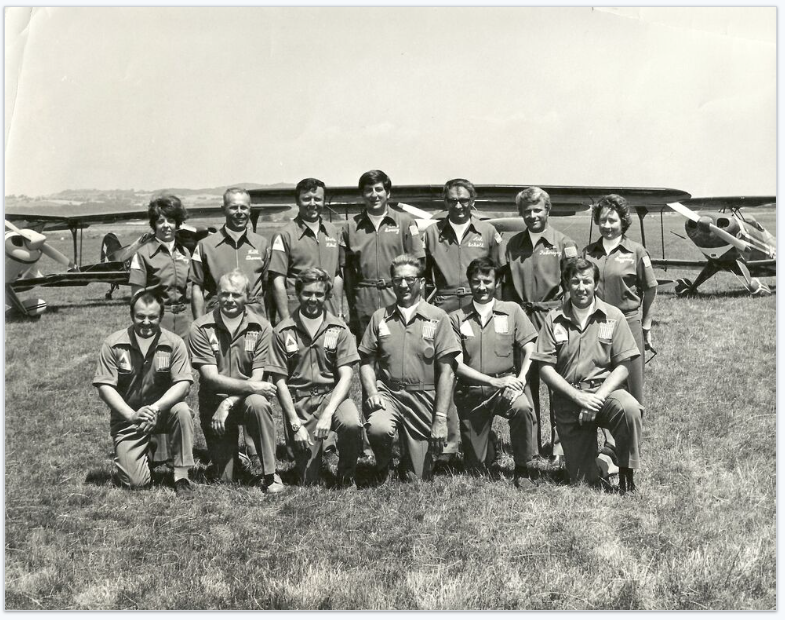
Poberezny: That was interesting, unique - a mixed team. We had Charlie, Art Scholl, Gene, myself and Bill Thomas - three guys with varying levels of experience and two new pilots, plus Carolyn Salisbury and Mary Gaffaney - a total of seven. There was great support from the entire team. The pilots had to go out and perform. However, the mechanics, trainers, team manager, judge - everybody worked together for the good of the team. It's as much mental training as physical. Mental - are you prepared? Have you practiced? You know what is required. The pilots critiqued each other. By the time we went to the compeition, it was a matter of wanting to win individually, but also wanting to win as a team.
Lammers: Tell us about your personal preparation
Poberezny: When I tried-out for the team, it was eight flights - a Known, two Freestyles and an Unknown. Then you repeated it. All eight flights were team selection and the last four were for the National Championship. In the Known back then, we started by coming in with a snap and a half and a 45 down line. There was onepart where you went from an extended negative g for a number of maneuvers to a positive. I was having trouble with that sequence in terms of going a little fuzzy. When I went into compeition I was nervous, and what happened? I went fuzzy and drifted out of the box on the first flight. That gave me incentive, and I decided 'let it go'. By the fourth flight, I was in the top five. That showed me that when you make a mistake, forget it and move on. If you fly well the rest of the time, you can overcome it. If you let a mistake bother you, you make another and another. In practice, if you work hard - don't think about making mistakes, think about doing it right - then when a mistake happens, you fly right through it. I enjoyed practicing; refining the routing, but it also developed mental toughness. Aerobatic competition made me a better pilot because it made me think about details you don't ordinarily consider. Aerobatic competition is very intense, very specific, very finite. The people watching you are looking for the smallest bobble. Compared to air show flying where you are entertaining peoploe, competition is about flying with great precision.
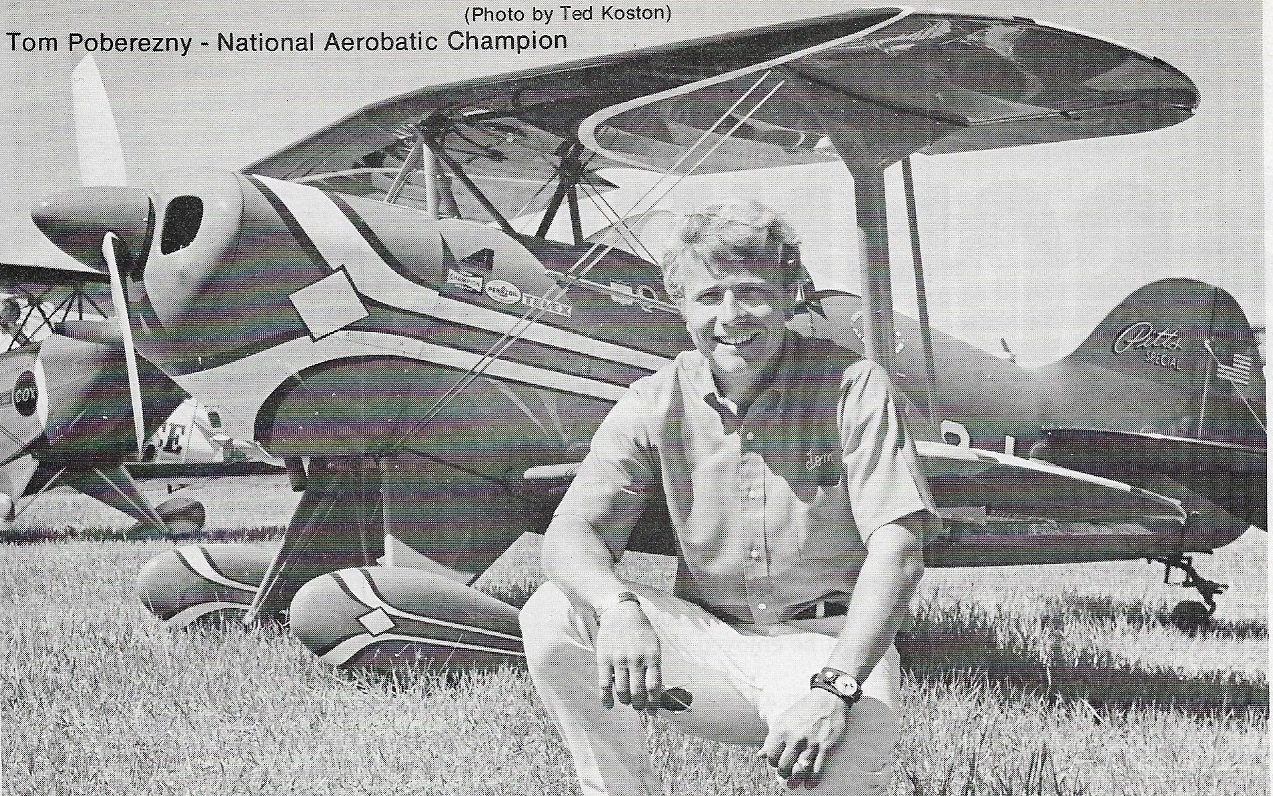
Lammers: The following year you became the U.S. National Aerobatic Champion. What was it like to win a national championship?
Poberezny: It was overwhelming, because my first competition was in 1970, and my first Unlimited wsa in the fall of 1971. A year later, I had been to the WAC where Charlie, Gene and I won the World Team Championships and I had finished sixth in the world. It was one thing to compete, but suddenly I was going head-to-head against people like Gene, Charlie, Art Scholl, Bob Herendeen - people who were far ahead of me. I used to watch them fly, and now, I don't think I realized how good I felt until the next morning. At the banquet that night, I said, "From this point on, maybe instead of knowing me as Paul Poberezny's son, he'll be known as Tom Poberezny's father." To be quite honest, I would have never been able to become an accomplished air show performer had it not been for what I learned in aerobatic compeition.
Lammers: Tell us about moving to air shows and forming the Red Devils. What principles guided the team so successfully for 25 years?
Poberezny: The Red Devils started in Rockford, Illinois in teh late '60's with Gene, Marion Cole and Bob Heuer, something they put together in the sky - they weren't even red at the time. 1971, when the U.S. Team was seleted, Charlie, Gene and I got together and flew a loose formation act. We had been practicing together at Oak Grove Airport. Charlie was flying the Spinks Akromaster and Gene and I were flying PItts. It was really loose because when Charlie lowered the nose of the Spinks Akromaster, "it was gone". It was just three planes in the sky. Charlie, Gene and I used to laugh, call ourselves "the Thrillos." Charlie said we thirlled each other not knowning where everybody was going to be. The winter of '71-72', Charlie brought Bob Heuer's Pitts-N442X, and we flew at Transpo '72, the major transporation show. It was a one-shot deal as part of the opening of Dulles Airport.
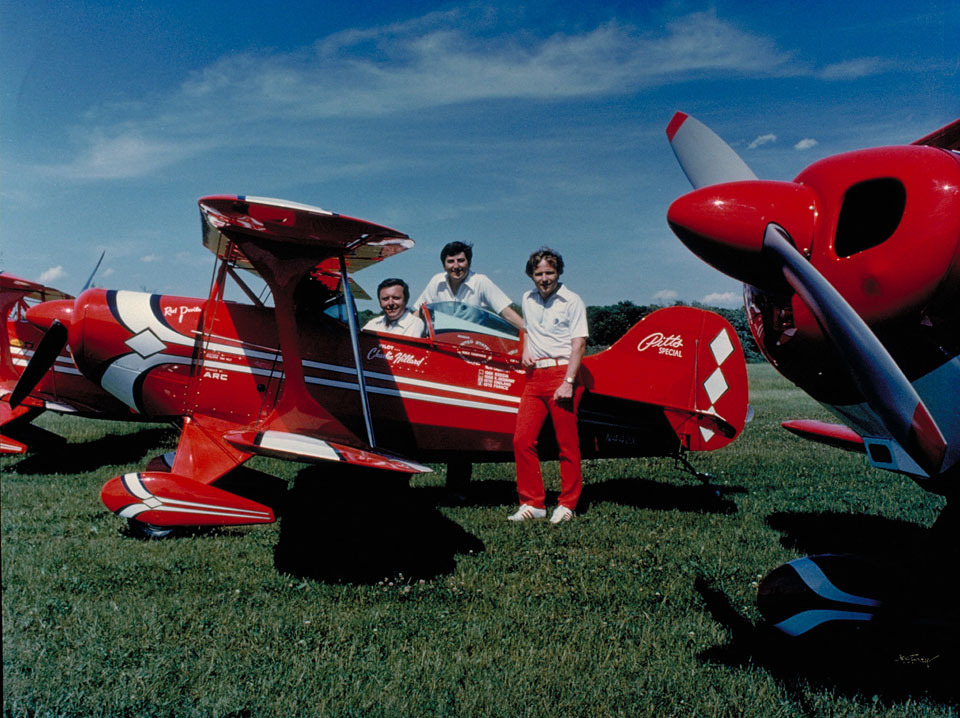
In the spring of 1972, we put together an act under the banner of the Red Devils. (photo EAA Archives) Mike Murphy, who for years was one of the true greats in aerobatic competition, watched us and said, "Fellows, just ha a busy sky." Beyond safety, that weas our guiding principle...a busy sky - something always going on. We flew a few shows that fall. Each year we received more calls and more people saw us. The more we flew, the tighter the formation got. The first few years, we had no radios - it was all hand signals, trust and timing. Then we installed radios - that was like we died and went to heaven.
Frank Christensen came along with the Eagle design. At one of the competitions around '78 or '79, Frank asked if he built three airplanes to our specifications, would we transfer from the Pitts to the Eagle? That transitition was made and allowed us to become a more professional entertainment act. Dealing with Frank was outstanding. He was the kind of guy who set a high standard and accepted nothing less. I think it was about '85 or '86 when we bought the airplanes from Frank.
Lammers: In the later years of the team, how did you balance your increasing responsibilities with EAA and keep the Eagles Aerobatic Team in the forefront?
Poberezny: Between the late '70's and early '80's my life started to change. We went from the Red Devils to the Eagles, my daughter Lesley, was born, and the EAA was expanding. Responsibilities and demands on my time was increasing. The Eagles peaked around the late '80's. My life with EAA was growing and family was very important to me. On the road with the Eagles, I met many people invovled with EAA. It was the best of both worlds because EAA, air shows and fly-ins were
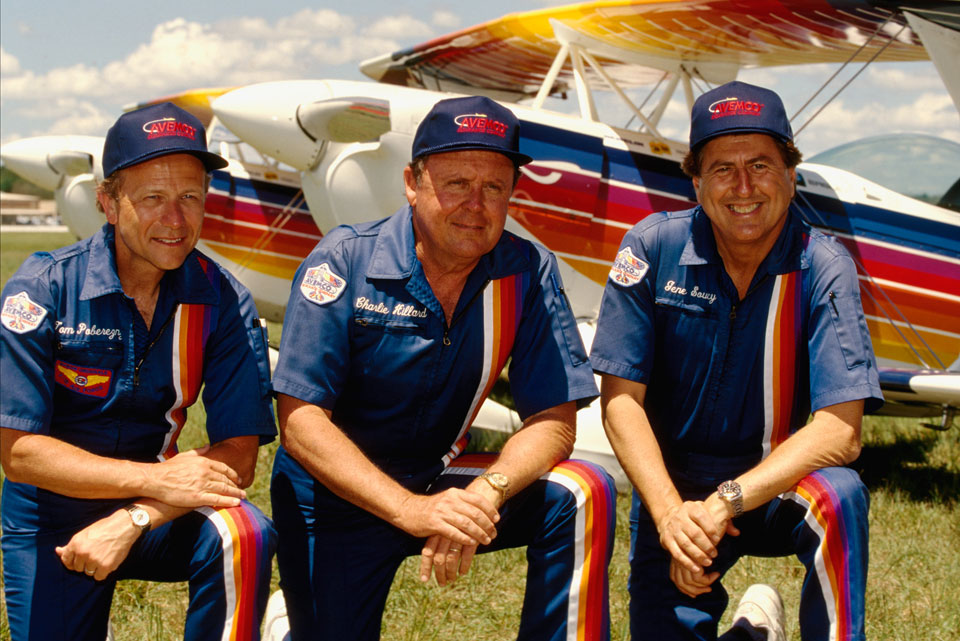
all molded together. What helped me tremendously was that, in leading the organization, I wasn't just an administrator, I was recognized as a pilot. I was gaining credentials and respect in understanding maintenance and aircraft performance. I had the depth of experience I needed on the practical side to offset the needs of being an administrator. This organization is in business to serve members. You have responsibilities to both staff and members who expect service and response to what they need. In the early '90's, I realized, "This can't go on forever." We retired the Eagles in November '95, having agreed to that three years earlier. The last year was our "swan song". It was a chance for us to acknowledge our friends and vice versa. It was a year I will never forget. (Eagles photo from EAA Archives)
Lammers: What has your association with sport aerobatics taught you about life?
Poberezny: The competitive side brought a true focus - teaching me the balance between knowing your limitations and the airplane's capabilities . . . how far to push and to recognize limis. There is a pride in competition. You are competing against yourself. It's just you adn the judge. I like that.

